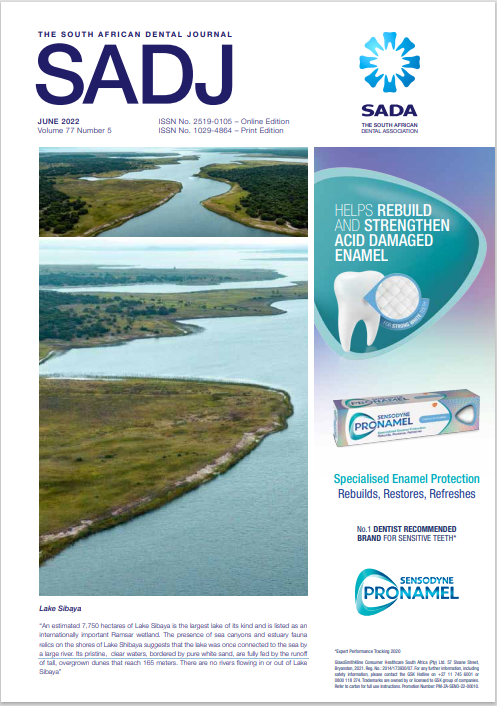Diagnosis and treatment of a maxillary lateral incisor with two root canals. A case report.
DOI:
https://doi.org/10.17159/2519-0105/2022/v77no5a6Keywords:
Maxillary lateral incisor, separate apical foramen, two canals, morphological root canal anomalies.Abstract
Although endodontic treatment has shown high success rates, the factors involved in the failure cases are still being studied. In this sense, the complexity of interradicular anatomy may lead to inadequate instrumentation and the persistence of etiological factors related to apical periodontitis and endodontic failure. The present case report illustrates the occurrence, diagnosis and nonsurgical endodontic treatment of a maxillary lateral incisor with two canals. A 24-year-old Peruvian woman was referred complaining of darkening of the upper front tooth. After clinical examination, the patient was diagnosed with necrotic pulp and asymptomatic apical
periodontitis. Still, radiographic examination revealed a disruption in the canal continuity, leading to a suspicion of unusual root canal morphology in the maxillary lateral incisor. By taking radiographs from different angles, according to the technique described by Clark, the presence of two independent canals was verified. Since most cases of endodontic failure are due to untreated canals, a predictable endodontic therapy must achieve the removal and neutralisation of etiologic factors related to periapical infiltration. The occurrence of additional root canals requires a correct interpretation of radiographic images to detect these variants and take the necessary considerations for proper endodontic treatment.
Downloads
References
Friedman S, Abitbol S, Lawrence HP. Treatment outcome in endodontics: the Toronto Study—phase 1: initial treatment. J Endod. 2003; 29(12):787–93.
Setzer FC, Boyer KR, Jeppson JR, Karabucak B, Kim S. Long-term prognosis of endodontically treated teeth: a retrospective analysis of preoperative factors in molars. J Endod. 2011; 37(1):21–5
Siqueira JF. Reaction of periradicular tissues to root canal treatment: benefits and drawbacks. Endod Topics. 2005; 10(1):123–47.
Gomes BPFA, Pinheiro ET, Jacinto RC, Zaia AA, Ferraz CCR, Souza-Filbo FJ. Microbial analysis of canals of root-filled teeth with periapical lesions using polymerase chain reaction. J Endod. 2008; 34(5):537–40.
Hoen MM, Pink FE. Contemporary endodontic retreatments: an analysis based on clinical treatment findings. J Endod. 2002(12); 28:834–6.
Song M, Kim H, Lee W, Kim E. Analysis of the Cause of Failure in Nonsurgical Endodontic Treatment by Microscopic Inspection during Endodontic Microsurgery. J Endod. 2011;7(11):1516-19.
Khan M, Rheman K, Saleem M. Causes of Endodontic Treatment Failure-A Study. Pakistan Oral & Dental Journal 2010; 30(1):232-6.
Tabassum S, Khan FR. Failure of endodontic treatment: The usual suspects. Eur J Dent. 2016;10(1):144–147.
Olcay K, Ataoglu H, Belli S. Evaluation of Related Factors in the Failure of Endodontically Treated Teeth: A Cross-sectional Study. J Endod. 2018;44(1):38-45.
Cohen S, Hargreaves KM, Berman LH. Cohen's Pathways of the Pulp. 10th ed. St. Louis, MO: Mosby; 2010.
Martins, J. N. R., Marques, D., Mata, A., & Caramês, J. Root and root canal morphology of the permanent dentition in a Caucasian population: a cone-beam computed tomography study. Int Endod J. 2017; 50(11): 1013–1026.
Estrela, C, et al. Study of Root Canal Anatomy in Human Permanent Teeth in A Subpopulation of Brazil's Center Region Using Cone-Beam Computed Tomography - Part 1. Braz Dent J. 2015; 26(5): 530-536.
Pan, J., Parolia, A., Chuah, S. R., Bhatia, S., Mutalik, S., & Pau, A. Root canal morphology of permanent teeth in a Malaysian subpopulation using cone-beam computed tomography. BMC oral health. 2019; 19(1): 14.
Martins JN, Marques D, Silva EJNL, Caramês J, Versiani MA. Prevalence Studies on Root Canal Anatomy Using Cone-beam Computed Tomographic Imaging: A Systematic Review. J Endod. 2019 Apr;45(4):372-386.
Ahlbrecht CA, Ruellas ACO, Paniagua B, Schilling JA, McNamara JA Jr, Cevidanes LHS. Three-dimensional characterization of root morphology for maxillary incisors. PLoS One. 2017 Jun 8;12(6): e0178728. doi: 10.1371/journal.pone.0178728. eCollection 2017.
Sert S, Bayirli G. Evaluation of the Root Canal Configurations of the Mandibular and Maxillary Permanent Teeth by Gender in the Turkish Population. J Endod. 2004; 30(6): 391-8.
Ahmed HM, Hashem AA. Accessory roots and root canals in human anterior teeth: a review and clinical CASE REPORT < 297considerations. Int Endod J. 2016 Aug;49(8):724-36.
Park PS et al. Three-dimensional analysis of root canal curvature and direction of maxillary lateral incisors by using cone-beam computed tomography. J Endod. 2013; 39(9):1124-9.
Romano N, Souza-Flamini L, Lima I, Gariba R, Miranda A. Geminated Maxillary Lateral Incisor with Two Root Canals. Case Rep Dent. 2016; 3759021. doi: 10.1155/2016/3759021.
Elbay M, Kaya E, Elbay Ü&, Sarıdağ S, Sinanoğlu A. Management of two-rooted maxillary central and lateral incisors: A case report with a multidisciplinary approach involving CAD/CAM and CBCT technology. J Pediatr Dent. 2016;(4):51-4.
Saberi, E., Bijari, S., & Farahi, F. Endodontic Treatment of a Maxillary Lateral Incisor with Two Canals: A Case Report. Iran Endod J. 2018; 13(3), 406–408.
Kishan KV, Hegde V, Ponnappa KC, Girish TN, Ponappa MC. Management of palato radicular groove in a maxillary lateral incisor. J Nat Sci Biol Med. 2014; 5(1):178–181.
Barzuna M. Dens in dente: anomalía dental difícil de tratar. reporte de un caso clínico. Rev. Cient. Odontol. 2013; 9(2): 35-38.
Sapp P, Eversole L, Wysocki G. Contemporary Oral and Maxillofacial Pathology 2nd. ed. Ámsterdam, MO: Mosby; 2004.
Low JF, Mohd Dom TN, Baharin SA. Magnification in endodontics: A review of its application and acceptance among dental practitioners. Eur J Dent. 2018; 12(4): 610–616.
Downloads
Published
Issue
Section
License

This work is licensed under a Creative Commons Attribution-NonCommercial 4.0 International License.





.png)